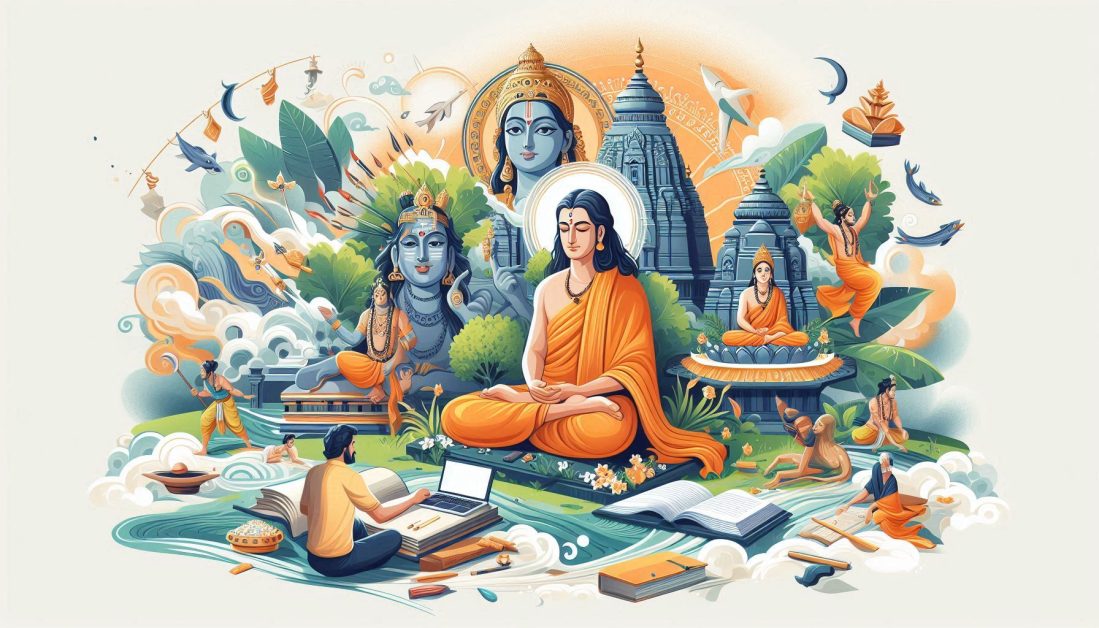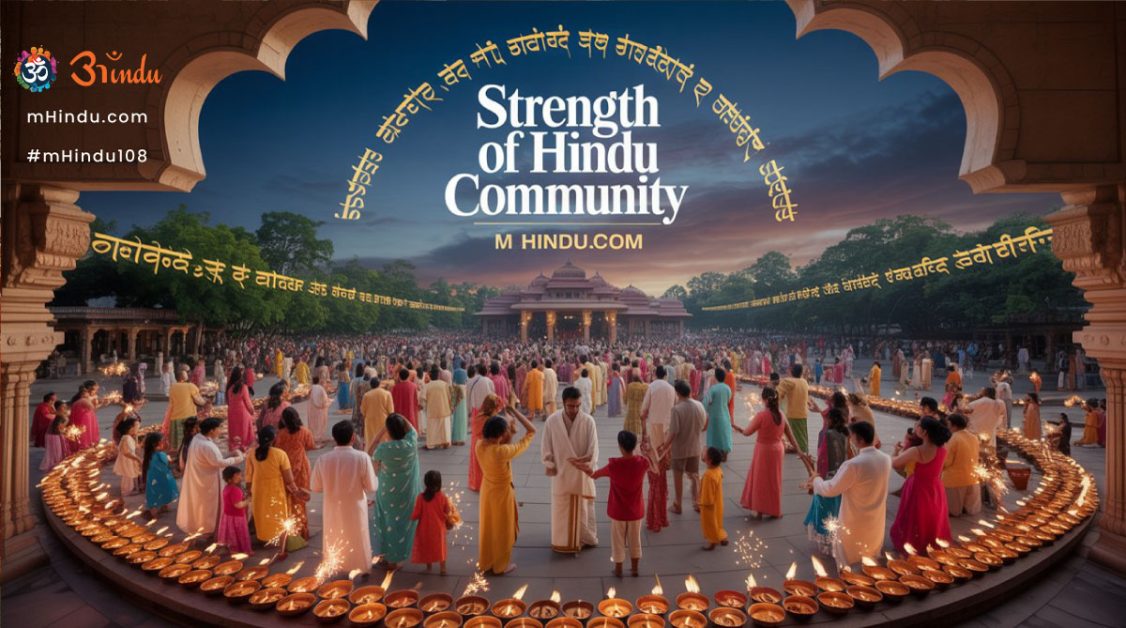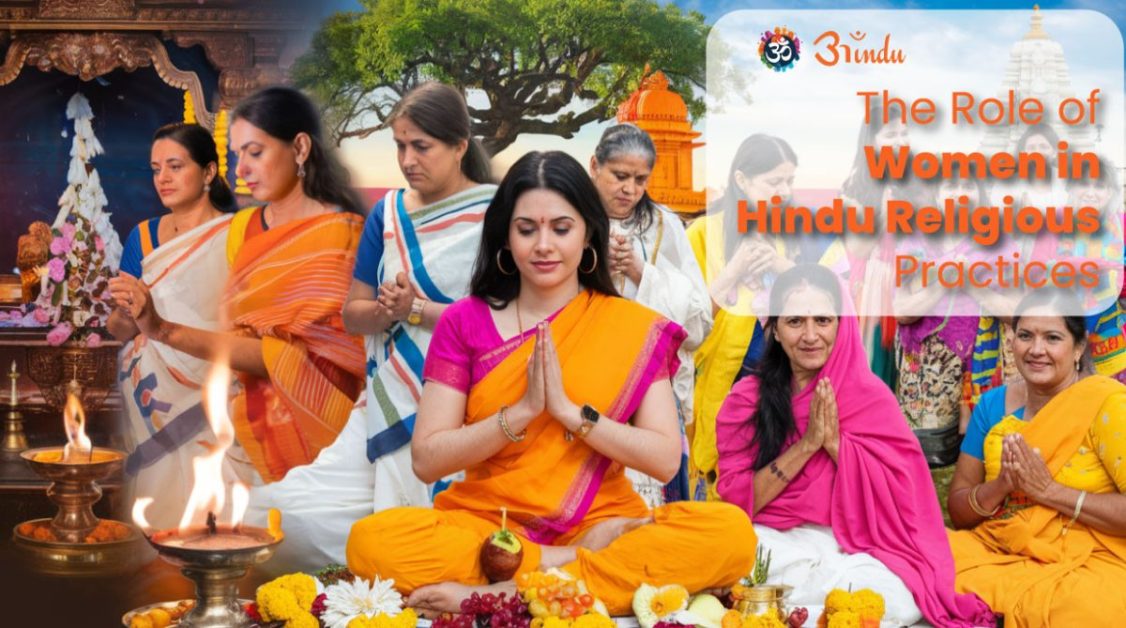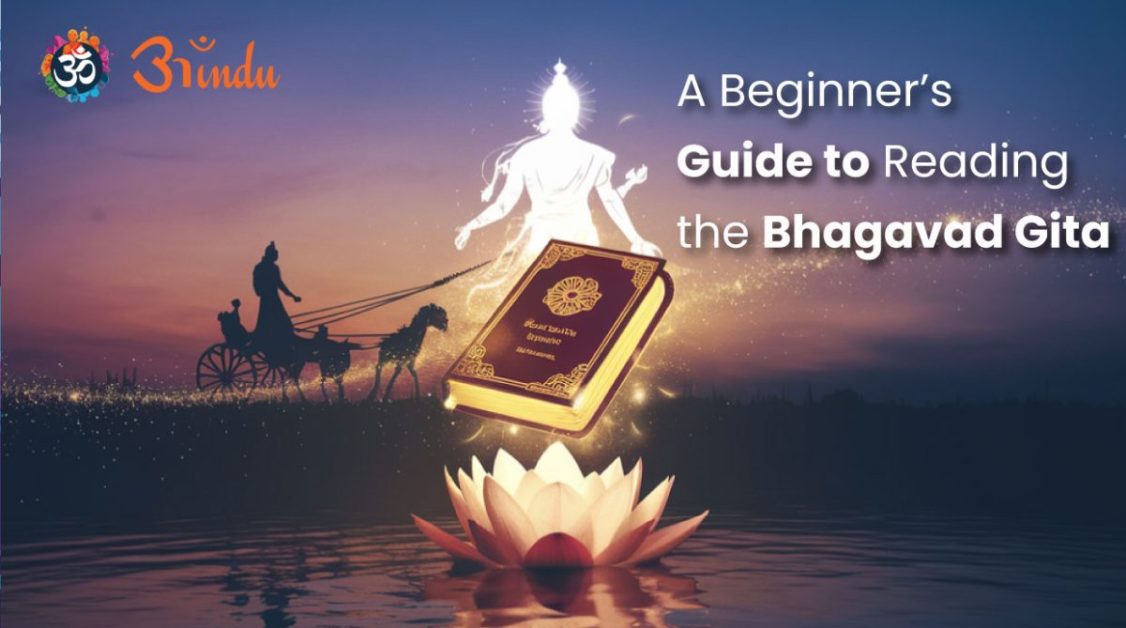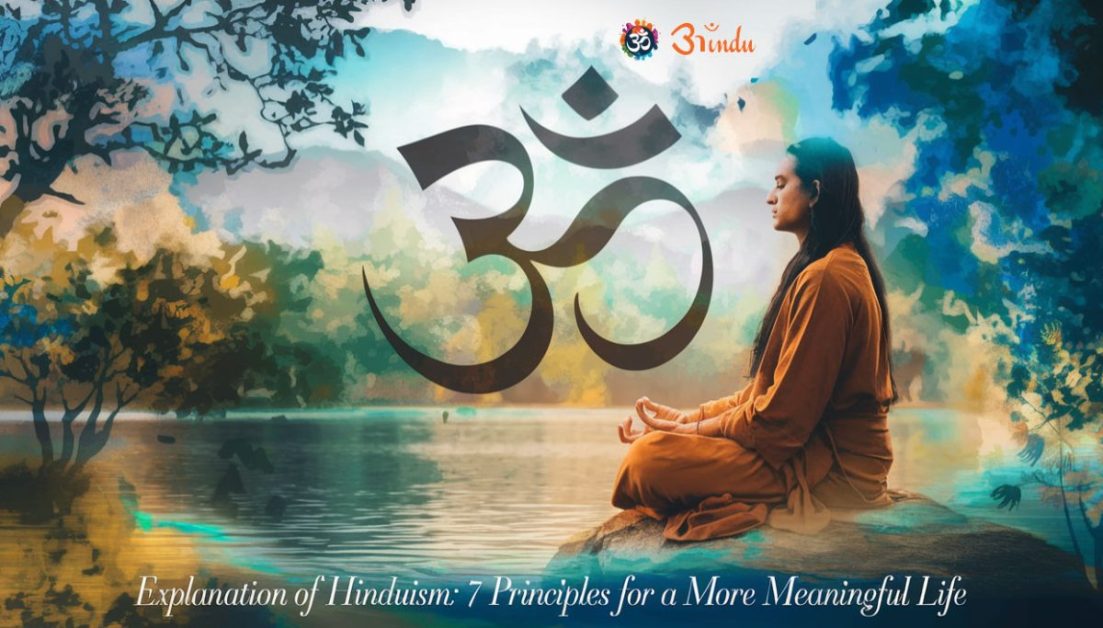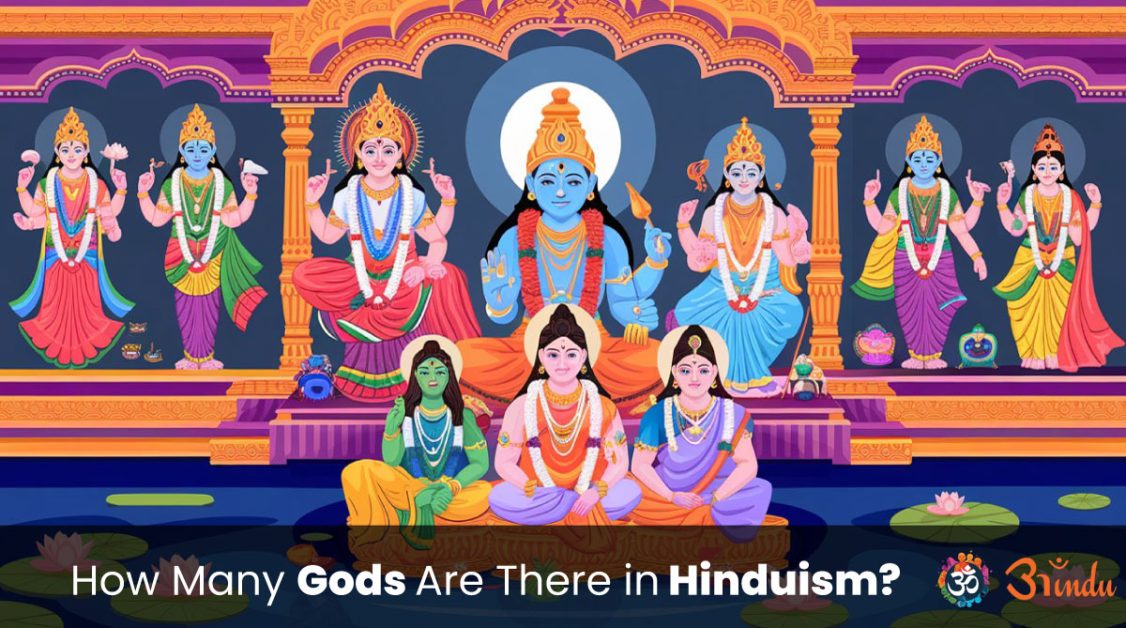
The question, how many gods are there in Hinduism, often arises when people encounter the rich tapestry of deities within Sanatan Dharma. It’s a question that delves into the heart of Hindu spirituality, revealing a complex and nuanced understanding of the divine. This blog post aims to provide a comprehensive exploration of this question, moving beyond simple numerical answers to understand the deeper philosophical and cultural significance of the vast Hindu pantheon.
Explore Blog Content
ToggleIntroduction: Beyond Numbers, Exploring Divine Manifestations
When faced with the question of how many gods are there in Hinduism, many are met with the answer “33 crore.” However, understanding this number requires delving deeper into the philosophical and cultural contexts of Hinduism. It’s not merely a matter of counting; it’s about comprehending the nature of the divine and its diverse manifestations. We’ll explore how Hinduism views divinity, addressing the common misconceptions and revealing the profound spiritual truths embedded within its vast pantheon.
"एकं सत् विप्रा बहुधा वदन्ति"
"Truth is one; the wise call it by various names."
The Philosophical Foundation: One Supreme Reality, Many Forms
At the core of Hinduism lies the concept of Brahman, the ultimate, formless, and all-pervading reality. This concept is crucial to understanding how many gods are there in Hinduism.
Brahman as the Ultimate Reality:
- Hinduism asserts that Brahman is the singular, supreme reality from which all existence emanates. The various deities are seen as different manifestations or aspects of this one Brahman.
- The phrase “Ekam Sat Vipra Bahudha Vadanti” (Truth is one; the wise call it by various names) encapsulates this idea, emphasizing that the diverse deities are different paths to the same ultimate truth.
Saguna and Nirguna Brahman:
- Brahman can be understood in two ways: Nirguna Brahman, the formless and attributeless absolute, and Saguna Brahman, the personal God with attributes. The many deities we worship are Saguna forms, making the divine accessible and relatable to human understanding.
- This concept is similar to how one artist may create many paintings, each different, but all from the same artist.
Ishta Devata: Personal Deity:
- Each individual may choose an Ishta Devata, a personal deity, as the focus of their devotion. This allows for a deeply personal and intimate connection with the divine, regardless of how many gods in Hinduism.
The Significance of “33 Crore Devas”: A Symbolic Representation
The term “33 crore devas” is a common answer to how many gods are there in Hinduism, but its meaning is often misunderstood.
Understanding “Crore”:
- “Crore” can mean “types” or “categories,” not just the numerical value of 10 million. Therefore, “33 crore devas” signifies 33 categories of divine beings.
- Those 33 categories consist of 8 Vasus, 11 Rudras, 12 Adityas, Indra and Prajapati.
Symbolic Meaning:
- This symbolic representation highlights the vastness and complexity of the divine, encompassing various aspects of nature and human experience. It is not intended to be a literal count of individual deities.
- This number represents the vastness of the cosmos, and the many ways that the divine can interact with the world.
"यदा यदा हि धर्मस्य ग्लानिर्भवति भारत। अभ्युत्थानमधर्मस्य तदात्मानं सृजाम्यहम्॥"
"Whenever there is a decline in righteousness and a rise in unrighteousness, O Arjuna, then I manifest Myself."
The Roles of Devas and Devis: Cosmic Functions and Archetypes
To grasp how many gods in Hinduism, we must understand the roles of Devas and Devis.
The Trimurti: Creation, Preservation, and Destruction:
- Brahma, Vishnu, and Shiva represent the fundamental cosmic functions. Brahma is the creator, Vishnu the preserver, and Shiva the destroyer.
- These deities work in harmony to maintain the cosmic order, demonstrating the interconnectedness of all things.
Devis: The Divine Feminine:
- Devis like Durga, Lakshmi, and Saraswati embody the divine feminine energy, or Shakti. They represent power, prosperity, and knowledge, respectively.
- They are equally revered as the male deities, underscoring the balance of masculine and feminine energies in the cosmos.
Avatars: Incarnations of Vishnu:
- Vishnu’s avatars, such as Rama and Krishna, are significant manifestations of the divine. They descend to Earth to restore dharma and guide humanity.
- Each avatar teaches valuable lessons and provides a model for righteous living.
The Importance of Mythology and Symbolism
Hindu mythology plays a crucial role in conveying spiritual truths and understanding how many gods are there in Hinduism.
Puranas and Itihasas:
- The Puranas and Itihasas (epics) are rich with stories and symbolism that illustrate deeper philosophical concepts.
- These narratives serve as moral and ethical guides, teaching dharma and karma through engaging stories.
Symbolic Representations:
- Each deity’s iconography is laden with symbolism. The weapons, postures, and vehicles they are depicted with all carry specific meanings.
- These symbols help devotees connect with the divine on a deeper level, understanding the qualities and attributes of each deity.
Regional Variations and Folk Deities
The question of how many gods are there in Hinduism is further complicated by regional variations and folk deities.
Regional Deities:
- Different regions of India have their own unique deities and forms of worship, reflecting local cultures and traditions.
- For example, Murugan in South India and Vithoba in Maharashtra.
Folk Deities:
- Alongside the major deities, numerous folk deities are worshipped in villages and rural areas, representing local spirits and protectors.
- These deities often reflect the close connection between people and their natural environment.
Deva and Devi Worship: Rituals and Practices
The act of worship, or puja, is central to Hindu spirituality, regardless of how many gods are there in Hinduism.
Puja and Aartis:
- Puja involves offering flowers, fruits, incense, and other items to the deity, while aartis are performed to honor the divine.
- These rituals create a sacred space for communion with the divine.
Mantras and Chants:
- Mantras and chants are powerful tools for invoking the divine, creating vibrations that resonate with cosmic energy.
- The repetition of sacred sounds helps purify the mind and connect with the divine.
Festivals and Celebrations:
- Hindu festivals are vibrant expressions of devotion and celebration, bringing communities together to honor the deities.
- These festivals provide opportunities for joy, devotion, and cultural expression.
Summary: Understanding the Divine Abundance
The question, how many gods are there in Hinduism, leads us to a deeper understanding of the divine’s multifaceted nature. The concept of Brahman, the symbolic representation of “33 crore devas,” the roles of Devas and Devis, the rich mythology, regional variations, and devotional practices all contribute to the vast and vibrant Hindu pantheon. It’s not about a simple numerical answer, but about appreciating the diverse manifestations of the one supreme reality.
By exploring these aspects, we gain a profound appreciation for the depth and breadth of Sanatan Dharma. We encourage you to delve into the mythology, engage in devotional practices, and connect with the deities that resonate with you. This journey will provide a richer understanding of the divine and your own spiritual path.
FAQ
- How many deities are there in Hinduism?
Hinduism speaks of “33 crore devas,” often misinterpreted as 330 million. It signifies 33 categories of divine beings, not a literal count. Deities are seen as manifestations of the one Brahman, making the concept of “many” a symbolic representation of divine abundance. - How many Indian gods are there?
“Indian gods” typically refers to the deities of Hinduism. The number is symbolically “33 crore,” representing 33 categories, not a fixed number. These deities are diverse manifestations of Brahman, reflecting the vastness of cosmic functions and spiritual truths. - How many deities in Hinduism?
The common answer, “33 crore,” represents 33 categories of divine beings. This signifies the vastness of the divine, with deities as expressions of the one supreme reality, Brahman. Understanding this requires seeing beyond a numerical count to grasp the symbolic richness. - How many gods in Hinduism religion?
Hinduism’s “33 crore” symbolizes 33 categories of divine beings. These are not separate gods, but manifestations of Brahman. This reflects the religion’s inclusive nature, where diverse deities represent various aspects of the singular, ultimate reality, allowing for varied paths of worship. - How many gods are there in Hinduism and their names?
“33 crore” signifies 33 categories, not a list of names. Prominent deities include Brahma, Vishnu, Shiva, Durga, Lakshmi, and Saraswati. Each deity has numerous names and forms, reflecting their diverse attributes and functions, all stemming from the one Brahman. - How many gods and goddesses are there in Hinduism?
The “33 crore” represents 33 categories of divine beings, encompassing both gods and goddesses. These deities are manifestations of Brahman, with goddesses (Devis) representing Shakti, the divine feminine energy, balancing the cosmic forces alongside the gods (Devas). - How many Hindu gods in the world?
Hindu deities are not confined to geographical boundaries. Their presence is seen as universal, as manifestations of Brahman, the all-pervading reality. The “33 crore” signifies the vastness of this divine presence, transcending any single location and existing within the cosmic order. - How many gods in Hinduism?
Hindus recognize “33 crore” as 33 categories of divine beings. These deities are manifestations of the one Brahman, allowing for personal devotion through Ishta Devata. This reflects the inclusive nature of Hinduism, where diverse paths lead to the same ultimate reality.

